Things you should know about the Chinese playing cards
- hariolus1995
- Jun 8, 2020
- 3 min read
In 105, an eunuch named Lun Cai (蔡伦) improved the fabrication of paper using low cost materials.

In the 7th century, during the dynasty Tang, the woodblock printing was invented.
In the 11th century, Sheng Bi (毕昇)invented the movable type printing which allowed the mass production. These are the important factors for the expansion of playing cards.
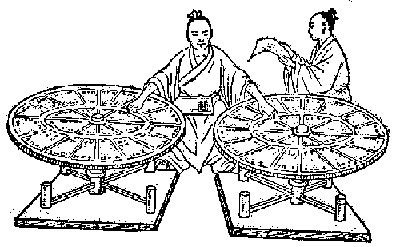
Leaf Game (叶子戏 Ye Zi Xi)
The word "leaf" in old Mandarin meant both paper and tree leaf because people used to take notes on them.
The earliest and most recognized reference to the game was The Biography of Princess Tong Chang (《同昌公主转》Tong Chang Gong Zhu Zhuan)by E Su(苏鹗) between 885 and 888. In the book it says: “The Weis like leaf game. ”(韦氏诸宗,好为叶子戏)
Before the leaf game, there was a type called the leaf tablet (叶子格 ye zi ge) or Sheng Guan Tu (升官图 Table of Bureaucratic Promotion) played with 6 dices like the game of goose.
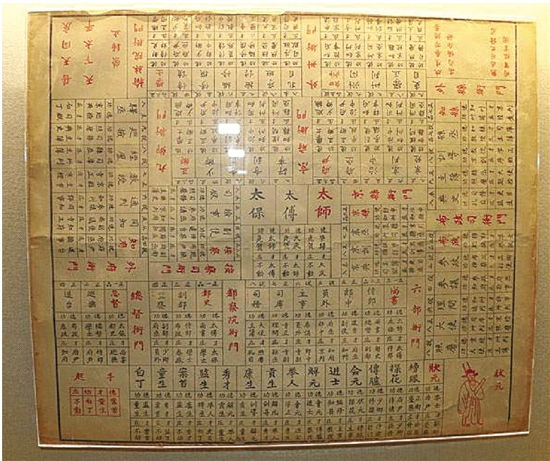
The book Xian Ding Lu(《咸定录》) by an anonymous in the Song dynasty claims that He Li (李郃) invented the leaf game saying: “He Li from the Tang Dynasty was the supervisor of the city He Zhou, during the trip by the river with the singer Maolian Ye, he wrote the book of the tablet, that's why he calls it the leaf game ”(唐李郃为贺州刺史,与妓人叶茂莲江行,因撰骰子选,谓之叶子戏)He selected some of the combinations from the total of 6 dices and drew them on leaves.

Chinese Domino 骨牌
They are also called Gu Pai(骨牌)骨means bones and 牌means cards, they were made of ivories.

The game was created in 1120 by Emperor Ji Zhao(赵佶), and became popular during the Gou Zhao(赵构)regime (1127-1162).
There are 32 cards in total, and each one has two dice combinations, and each combination has multiple points.
The entire deck is divided into 4 sections: Heaven, Earth, Civil, and Hu.
Jishan Cao(曹继善)from the same dynasty wrote a book called Drinking Game of An Ya Tang (《安雅堂觥律》An Ya Tang Chou Lü) and commented: "playing the leaf game with drinks, an amusement at a place of pleasure"(以叶子行觞,欢场雅事也)The game is composed of 119 cards.
Ma Diao 马吊牌
On Wikipedia it says that a Korean poet Jang Hon (1759-1828) wrote that this game, a derivation of the leaf game, chases back to the Yuan dynasty (1271-1368). Unfortunately I have not been able to find any information about the poet.
Many Chinese articles on this game mention that Ma Diao took his form in the Ming dynasty (1368—1644), but it is quite possible that a very similar type already existed in Yuan.
In Chinese, Ma (马) means horse, but it has the same pronunciation as 码, “chip” and Diao(吊) is thread, that is, the game means a thread of chips (coins).
Rong Lu(陆容)mentioned in his book Shu Yuan Za Ji (《菽园杂记》history and anecdotes ) about the structure of the deck, which is made up of 4 suits:
索 String (9 cards),
万 Myriad (9 cards),
十万 Ten myriads (11 cards),
文 Coins (9 cards), are 38 cards in total.
But then two more cards were added to the coin suit, and that's 40 cards.



The oldest discovered card of this pattern is found in Turfan (13th century) The words above(管换 guan huan)say refund insured, and the words below(贺造 he zao)say made in He, may indicate the place of manufacture He Zhou(贺州)

Comparison
According to Ulrich Kaltenborn, the correspondence between the Ma Diao deck, Mamluk deck and Spanish or Italian playing cards is following:
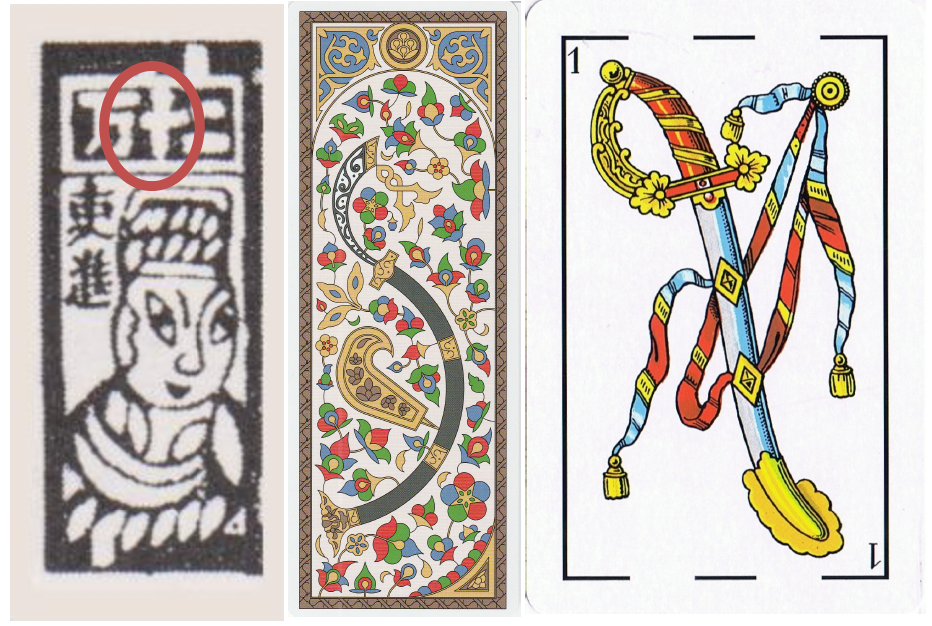
(According to Ulrich Kaltenborn, the Chinese character 十“ten” reminds the Arabians of the words)
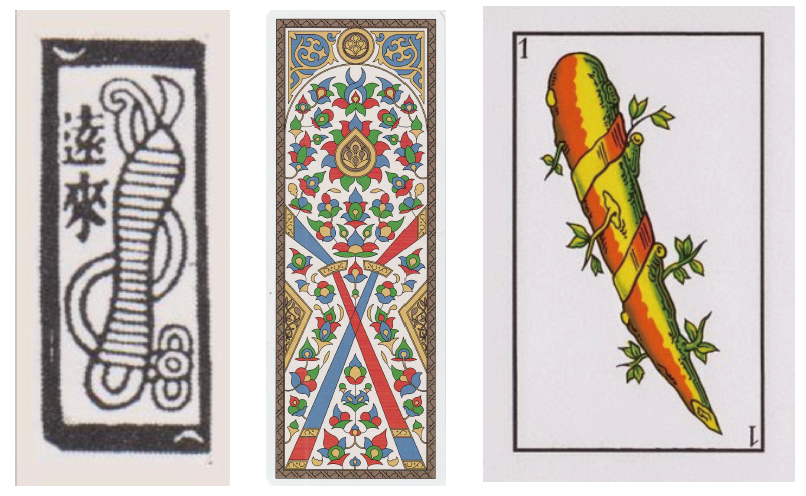

(According to Ulrich Kaltenborn, the Chinese character万“myriad”upside down looks like a cup)
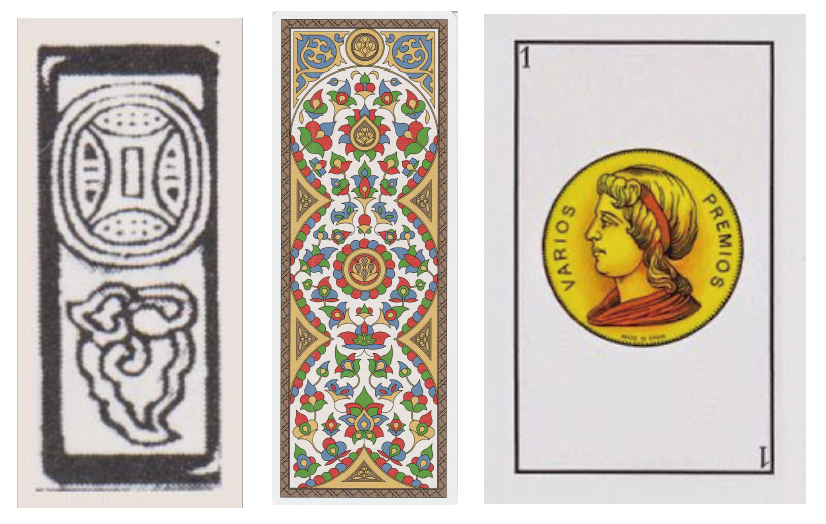
Reference
《李郃与唐代叶子戏》(2012) by 张介立
Chinese Origin of Playing Cards (1895) by W.H. Wilkinson
THE GAME OF MA-JONG. ITS ORIGIN AND SIGNIFICANCE (1924) by Stewart Culin







![[Interview] Ulrich Kaltenborn and his story with the Mamluk deck](https://static.wixstatic.com/media/2a2f00_188ef5dda41d48a2962b16be5a34298e~mv2_d_2643_1982_s_2.jpg/v1/fill/w_980,h_735,al_c,q_85,usm_0.66_1.00_0.01,enc_avif,quality_auto/2a2f00_188ef5dda41d48a2962b16be5a34298e~mv2_d_2643_1982_s_2.jpg)


Comments